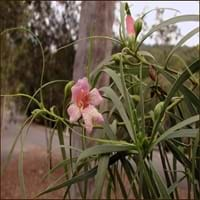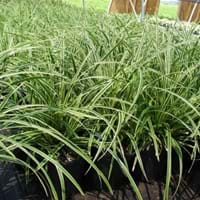Life Span
Perennial
Perennial
Origin
Hybrid origin
Japan
Types
Pixie Bush, Claypan Grass
Not Available
Habitat
Desert, Dry areas
Lawn, shaded fields, Shaded sites
USDA Hardiness Zone
9-11
5-9
Sunset Zone
8, 9, 13, 14, 15, 16, 17, 18, 19, 20, 21, 22, 23, 24
3a, 3b, 4, 5, 6, 7, 8, 9, 14, 15, 16, 17, 18, 19, 20, 21, 22, 23, 24
Habit
Upright/Erect
Clump-Forming
Minimum Height
Not Available
Minimum Width
Not Available
Flower Color
Magenta, Rose
Tan
Flower Color Modifier
Not Available
Bicolor
Fruit Color
Light Pink
Non Fruiting Plant
Leaf Color in Spring
Purple, Light Green, Gray Green
Green, Light Yellow
Leaf Color in Summer
Purple, Olive, Gray Green
Green, Light Yellow
Leaf Color in Fall
Purple, Olive, Gray Green
Green, Light Yellow
Leaf Color in Winter
Purple, Olive, Gray Green
Tan
Leaf Shape
Irregular
Long Narrow
Plant Season
Spring, Summer, Fall, Winter
Spring, Summer, Fall, Winter
Sunlight
Full Sun, Partial Sun
Partial shade, Full Shade
Growth Rate
Medium
Medium
Type of Soil
Loam, Sand
Clay, Loam
The pH of Soil
Acidic, Neutral, Alkaline
Acidic, Neutral
Soil Drainage
Well drained
Well drained
Bloom Time
Early Spring, Spring, Late Winter
Early Summer, Summer
Tolerances
Cold climate, Light Frost, Pollution
Drought
Where to Plant?
Ground, Pot
Container, Ground, Pot
How to Plant?
Grafting, Seedlings, Stem Planting
Divison, Seedlings
Plant Maintenance
Medium
Medium
Watering Requirements
Average Water Needs, Never Over-water, Requires watering in the growing season, Water when top layer of soil becomes dry
Average Water Needs
In Summer
Lots of watering
Lots of watering
In Spring
Average Water
Moderate
In Winter
Average Water
Average Water
Soil pH
Acidic, Neutral, Alkaline
Acidic, Neutral
Soil Type
Loam, Sand
Clay, Loam
Soil Drainage Capacity
Well drained
Well drained
Sun Exposure
Full Sun, Partial Sun
Partial shade, Full Shade
Pruning
Prune to stimulate growth, Remove damaged leaves, Remove dead leaves, Remove dead or diseased plant parts
Remove damaged leaves, Remove dead branches, Remove dead leaves
Fertilizers
All-Purpose Liquid Fertilizer, fertilize in spring, Nitrogen, Phosphorous
All-Purpose Liquid Fertilizer
Pests and Diseases
Insects, Red blotch
Red blotch
Plant Tolerance
Cold climate, Light Frost, Pollution
Drought
Flowers
Showy
Insignificant
Flower Petal Number
Single
Single
Foliage Texture
Fine
Fine
Foliage Sheen
Matte
Glossy
Attracts
Birds, Hummingbirds
Bees
Allergy
Skin irritation, Skin rash
Itchiness
Aesthetic Uses
Beautification, Landscape Designing, Showy Purposes
Showy Purposes
Beauty Benefits
Good for skin and hair, Improve hair condition, Improve skin condition
Not Available
Environmental Uses
Air purification, Food for insects, Prevent Soil Erosion, Versatility
Air purification
Medicinal Uses
No Medicinal Use
Not Available
Part of Plant Used
Flowers, Leaves
Not Available
Other Uses
Decoration Purposes, Showy Purposes, Used as Ornamental plant, Used for its medicinal properties
Not Available
Used As Indoor Plant
Yes
No
Used As Outdoor Plant
Yes
Yes
Garden Design
Container, Feature Plant, Foundation, Groundcover, Hedges, Mixed Border, Rock Garden, Wall, Screening, Wind Break, Tropical
Container, Edging, Groundcover, Mixed Border, Rock Garden / Wall
Botanical Name
EREMOPHILA 'Valentine'
Carex Morrowii
Common Name
Poverty Bush, Fuchsia bush
Japanese Sedge, Carex Grass Evergold
In Hindi
एमु बुश
Carex Grass Evergold
In German
Emu Bush
Carex Grass Evergold
In French
Emu Bush
Carex Grass Evergold
In Spanish
Emu Bush
Carex Grass Evergold
In Greek
emu Μπους
Carex Grass Evergold
In Portuguese
Emu de Bush
Carex Grass Evergold
In Polish
Emu Bush
Carex Grass Evergold
In Latin
Emu Bush
Carex Grass Evergold
Phylum
Tracheophyta
Tracheophyta
Class
Magnoliopsida
Magnoliopsida
Family
Myoporaceae
Cyperaceae
Clade
Angiosperms, Asterids, Eudicots
Angiosperms, Commelinids, Monocots
Tribe
Myoporeae
Not Available
Subfamily
Not Available
Not Available
Importance of Emu Bush and Carex Grass Evergold
Want to have the most appropriate plant for your garden? You might want to know the importance of Emu Bush and Carex Grass Evergold. Basically, these two plants vary in many aspects. Compare Emu Bush and Carex Grass Evergold as they differ in many characteristics such as their life, care, benefits, facts, etc. Every gardener must at least have the slightest clue about the plants he wants to plant in his garden. Compare their benefits, which differ in many ways like facts and uses. The medicinal use of Emu Bush is No Medicinal Use whereas of Carex Grass Evergold is Not Available. Emu Bush has beauty benefits as follows: Good for skin and hair, Improve hair condition and Improve skin condition while Carex Grass Evergold has beauty benefits as follows: Good for skin and hair, Improve hair condition and Improve skin condition.
Compare Facts of Emu Bush vs Carex Grass Evergold
How to choose the best garden plant for your garden depending upon its facts? Here garden plant comparison will help you to solve this query. Compare the facts of Emu Bush vs Carex Grass Evergold and know which one to choose. As garden plants have benefits and other uses, allergy is also a major drawback of plants for some people. Allergic reactions of Emu Bush are Skin irritation and Skin rash whereas of Carex Grass Evergold have Itchiness respectively. Having a fruit bearing plant in your garden can be a plus point of your garden. Emu Bush has no showy fruits and Carex Grass Evergold has no showy fruits. Also Emu Bush is not flowering and Carex Grass Evergold is not flowering . You can compare Emu Bush and Carex Grass Evergold facts and facts of other plants too.





